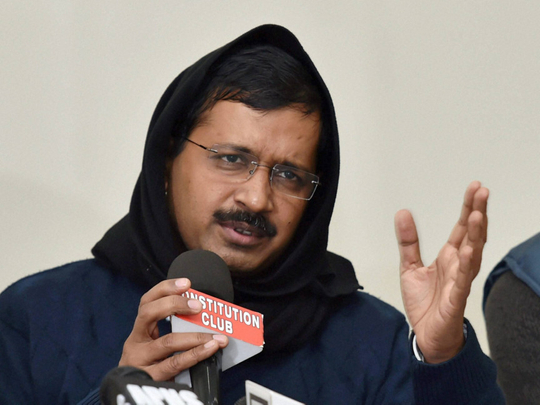
When Sachin Tendulkar was at his peak, Sir Richard Branson’s Virgin Comics announced plans to cast him as a super-hero with a flaming cricket bat in a series called The Master Blaster. And now Android Play store has launched a new free game — Muffler Man — inspired by Aam Aadmi Party (AAP) supremo Arvind Kejriwal who is always seen with a muffler wrapped around his head and neck as he keeps coughing and clearing his throat while talking to newsmen or addressing the party faithful.
As in real life, the central character of the newly-launched game is a dogged anti-corruption crusader modelled on Kejriwal. And AAP, not surprisingly, has capitalised on the Android game by launching Muffler Man T-shirts online ahead of do-or-die elections in Delhi on February 7 which will decide the floundering party’s fate once and for all in the country’s rapidly changing political landscape. I deliberately say ‘rapidly changing’ because the Delhi legislative assembly polls in February will be virtually a straight fight between AAP and the Bharatiya Janata Party; the Congress Party — generally regarded as the BJP’s principal challenger — has conceded defeat long before the first vote has been cast by announcing that it’s solidly backing AAP’s bid for power. But the moot question is: Can AAP recapture Delhi trouncing the BJP, which is winning election after election? No party has had such a meteoric rise or fall as AAP. And no politician has cast a spell over so many Indians in such a short span — or has been so vehemently derided — as Kejriwal. Born in November 2012, AAP made its electoral debut in the 2013 Delhi assembly polls emerging as the second-largest party with 28 seats while BJP bagged 31 and the Congress 8 in a 70-strong house. Kejriwal became the chief minister of an AAP government formed with Congress support in December 2013. But unable to pass laws in the hung legislature, the AAP government resigned in February 2014 after being in power for just 49 days. In the April-May 2014 parliamentary elections, AAP fielded 434 candidates nationwide — including Kejriwal who unsuccessfully took on Narendra Modi in Varanasi. But only four AAP contestants were elected — all from Punjab. Although AAP polled 32.9 per cent of votes in Delhi, it didn’t win a single parliamentary seat.
Spurt in popularity
Interestingly, despite such a dismal performance eight months ago, AAP is very much in the game in Delhi as electioneering picks up ahead of February polls. Statistically speaking, there was clearly a spurt in AAP’s popularity in Delhi when the last trial of strength took place. AAP polled 32.9 per cent of votes in Delhi during the 2014 parliamentary elections — nearly four per cent more than its vote-share in the 2013 Delhi assembly elections!
The BJP is inconsolable after the Congress offer of unconditional support to AAP. But the BJP’s real worry lies elsewhere: It’s dreading a straight fight with AAP. The BJP’s fear has intensified after Kejriwal’s gleeful response to the Congress offer. He has advised traditional Congress supporters to vote directly for AAP rather than elect Congress legislators who would anyway back AAP. The chances of triangular contests BJP was banking on are fast receding to the great discomfiture of its poll strategists. Anybody who is somebody in Delhi is privy to conspiracy theories, which ultimately trickle down to the masses. For instance, many believe that Modi is so wary of AAP that he launched the Clean India campaign soon after becoming the prime minister, brandishing the lowly jhaadu, or broom, which happens to be AAP’s powerful election symbol. Before its stunning poll debut in 2013, AAP zeroed in on the broom as its symbol to propagate its determination to sweep out corruption. Conspiracy theorists insist that Modi opted for the broom as the mascot of the high-voltage cleanliness drive only to snap up an election symbol long identified with AAP. The argument goes that Modi wants to confuse and mislead AAP’s vote-bank by quietly appropriating the jhaadu. Now let’s see whether the BJP’s ingenuity pays dividends at the hustings.
Evidently, BJP is pulling out all stops to ensure its victory. Kejriwal is the BJP’s prime target. As tempers rise, Modi has branded Kejriwal an “anarchist” and urged him to join the Naxalites, or left-wing extremists, instead of eyeing the Delhi CM’s chair once again. Significantly, Kejriwal had called himself an anarchist when he was the CM of the short-lived AAP regime. Besides Modi, newly-appointed BJP chief ministers of Maharashtra, Jharkhand and Haryana are desperately seeking votes in poll-bound Delhi.
If AAP was really a spent force, BJP wouldn’t be taking it so seriously. Despite a string of recent victories, BJP is apprehensive that those who voted for AAP in 2013 and 2014 in Delhi, won’t desert it in 2015. It also knows too well that AAP is much more than a mere political party. Sociologist-philosopher Shiv Visvanathan says it’s the “chrysalis of the future” and has compared it to an “out of form” star batsman. The election results will decide not only who will rule Delhi but AAP’s future too.
S. N. M. Abdi is a noted Indian journalist and commentator.












